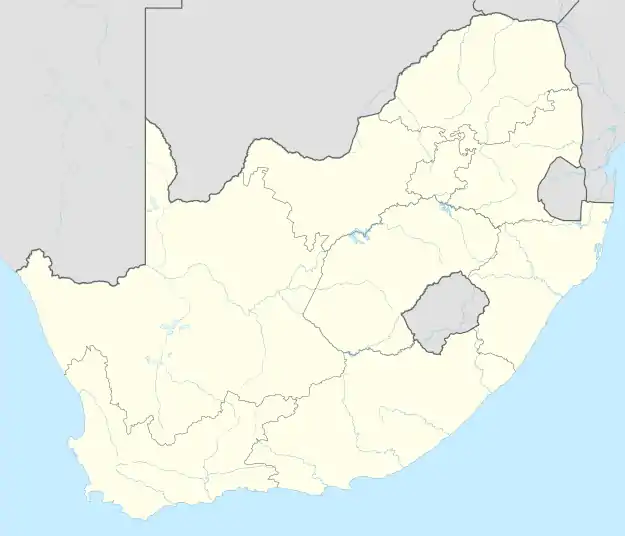Tongaat
Tongaat (Zulu: oThongathi[2]) is a town in KwaZulu-Natal, South Africa, about 40 kilometres (25 mi) north of Durban and 28 kilometres (17 mi) south of KwaDukuza. It now forms part of eThekwini Metropolitan Municipality, or the Greater Durban area. The King Shaka International Airport is 8 kilometres (5.0 mi) road. The R102 is a thoroughfare through the town from KwaDukuza and Ballito in the north to Verulam in the south. Its population is mostly people of Indian descent. The area is home to the oldest Indian community in South Africa, having been where the first indentured Indian laborers settled in 1860 to work in the sugar-cane plantations.[3] Much of the architectural style in the town was the work of Ivan Mitford-Barberton,[4] and many buildings are in the Cape Dutch style of architecture.
Tongaat
oThongathi | |
|---|---|
 Aerial view of Tongaat Beach | |
 Tongaat  Tongaat | |
| Coordinates: 29°34′00″S 31°07′00″E | |
| Country | South Africa |
| Province | KwaZulu-Natal |
| Municipality | eThekwini |
| Area | |
| • Total | 11.72 km2 (4.53 sq mi) |
| Population (2011)[1] | |
| • Total | 42,554 |
| • Density | 3,600/km2 (9,400/sq mi) |
| Racial makeup (2011) | |
| • Black African | 41.1% |
| • Coloured | 1.2% |
| • Indian/Asian | 56.7% |
| • White | 0.4% |
| • Other | 0.5% |
| First languages (2011) | |
| • English | 59.3% |
| • Zulu | 32.3% |
| • Xhosa | 3.6% |
| • S. Ndebele | 1.0% |
| • Other | 3.8% |
| Time zone | UTC+2 (SAST) |
| Postal code (street) | 4399 |
| PO box | 4400 |
| Area code | 032 |
History
Tongaat was established in 1945 and its name was taken from the name of the uThongathi River which passes by the town: The name of the river, derived from Zulu, is said to mean
'it is important to us' or 'you are important because of us', referring to legends involving reaction to a denigrating remark in the first instance, and to Shaka's magnanimous view of a tribe he had just made subservient to him[5]
In 2017 plans were made for the restoration of the historic railway station building.[6]
Commerce
The town is home to the headquarters of Tongaat Hulett Sugar.[7] Maidstone Sugar Mill, one of the country's first mills, completed in 1850 is nearby.
Notable people
- Ahmed Amla, cricketer
- Ansuyah Ratipul Singh, medical doctor and writer is commemorated with a statue[8] in the Amanzinyama Gardens located at 29°34′13″S 31°07′23″E.
- Cecil Pullan, cricketer
- Colin Munro, cricketer
- Hashim Amla,[9][10] cricketer
- Katharine Saunders, botanical illustrator
- Prenelan Subrayen, cricketer
- Quarraisha Abdool Karim, scientist was born here in 1960.[11]
- Thandeka Zulu, actress and musician
- Thomas Hassall, Australian politician
- Two-Boys Gumede, footballer
Notes and references
Citations
- "Main Place Tongaat". Census 2011.
- "More name changes". www.iol.co.za. Retrieved 2021-01-20.
- Watson 1960, p. 76, Ch 6.
- Watson 1960, p. 200.
- Raper 1989, p. 433.
- Hitchcock, Lynn (26 January 2017). "Former railway station revamp proposed". News24. Retrieved 2017-10-13.
- Chalmin 1990, p. 544.
- "Dr Ansuyah Ratipul Singh". South African History Online. 17 February 2011. Retrieved 2017-10-13.
- Retief, Hanlie (7 February 2016). "Amla: man in the moment". CityPress. Retrieved 15 July 2019.
a
- "Tongaat Primary- 96 years of heritage". Phoenix Sun. 6 March 2017. Retrieved 15 July 2019.
- Oppenheimer & Bayer 2007, p. 247.
Sources
- Chalmin, Philippe (1990). The Making of a Sugar Giant: Tate and Lyle, 1859-1989. Taylor & Francis. ISBN 978-3-7186-0434-0.
- Harrison, Philip (2004). South Africa's Top Sites: Spiritual. New Africa Books. ISBN 978-0-86486-564-9.
- Oppenheimer, Gerald M.; Bayer, Ronald (2007). Shattered Dreams: An Oral History of the South African AIDS Epidemic. Oxford University Press, USA. ISBN 978-0-19-530730-6.
- Raper, P. E. (1989). Dictionary of Southern African Place Names. J. Ball. ISBN 978-0-947464-04-2.
- Watson, Robert George Theodor (1960). Tongaati: An African Experiment. Hutchinson.
Further reading
- Hale, Emiline (1928). The thrills of Tiny Tongaat. Religious Tract Society.
- Reddy, E (1977). Religion and Rituals Amongst Hindus in Tongaat. University of Durban-Westville, Department of Anthropology.
- Petraglia, Michael D.; de la Peña, Paloma; Wadley, Lyn (2017). "Technological variability at Sibudu Cave: The end of Howiesons Poort and reduced mobility strategies after 62,000 years ago". PLOS ONE. 12 (10): e0185845. doi:10.1371/journal.pone.0185845. ISSN 1932-6203. PMC 5628897. PMID 28982148.
.svg.png.webp)